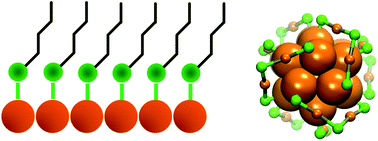Properties of the gold–sulphur interface: from self-assembled monolayers to clusters
Abstract
The gold–sulphur interface of self-assembled monolayers (SAMs) was extensively studied some time ago. More recently tremendous progress has been made in the preparation and characterization of thiolate-protected gold clusters. In this feature article we address different properties of the two systems such as their structure, the mobility of the thiolates on the surface and other dynamical aspects, the chirality of the structures and characteristics related to it and their vibrational properties. SAMs and clusters are in the focus of different communities that typically use different experimental approaches to study the respective systems. However, it seems that the nature of the Au–S interfaces in the two cases is quite similar. Recent single crystal X-ray structures of thiolate-protected gold clusters reveal staple motifs characterized by gold ad-atoms sandwiched between two sulphur atoms. This finding contradicts older work on SAMs. However, newer studies on SAMs also reveal ad-atoms. Whether this finding can be generalized remains to be shown. In any case, more and more studies highlight the dynamic nature of the Au–S interface, both on flat surfaces and in clusters. At temperatures slightly above ambient thiolates migrate on the gold surface and on clusters. Evidence for desorption of thiolates at room temperature, at least under certain conditions, has been demonstrated for both systems. The adsorbed thiolate can lead to chirality at different lengths scales, which has been shown both on surfaces and for clusters. Chirality emerges from the organization of the thiolates as well as locally at the molecular level. Chirality can also be transferred from a chiral surface to an adsorbate, as evidenced by vibrational spectroscopy.


 Please wait while we load your content...
Please wait while we load your content...